
Why Traveling from Tibet to Nepal Should Be on Your Bucket List
Tibet is often known as the roof of the world for its high elevation on the Qinghai-Tibet Plateau. With its high mountains and lush green valleys, the region is one of beautiful landscapes and wildlife. Full of monasteries and a unique culture, Tibet is a land where the mysteries of the universe are part of everyday discussion, and where drinking butter tea and eating Tsampa are seen as normal. For those who have traveled the rest of the world, you can guarantee Tibet has something that you have never seen. From the debating monks of the various monasteries to the nomadic herdsmen with their yaks on the wide, expansive prairies, the region is unique in both culture and religion, and it is sometimes hard to know where one stops and the other begins.
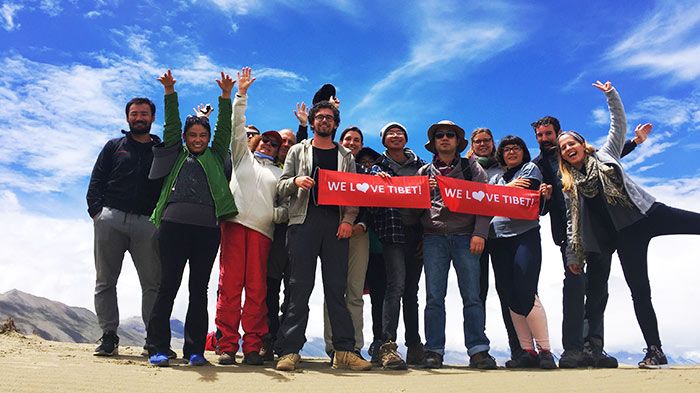 Travel from Tibet to Nepal
Travel from Tibet to Nepal
Nepal, similarly, is well known for its beautiful alpine scenery and tropical landscapes, as well as the sights in Kathmandu. With high mountains on the border with Tibet, Nepal can also offer some great mountain adventures, and also has a base camp at the foot of Everest, on the Nepali side of the mountain. Lower down the scenery turns to that of more tropical and sub-tropical climates, with lush green valleys, full of dense forests and clear lakes.
Experiencing the Tibetan Alpine Scenery and the Difference to the Nepali Landscape and Topography
At the high altitudes of Tibet, the scenery is often one of lofty mountains and arid lands, dotted with expansive lakes and tundra. Only in the summer months, when the monsoon rains come, do the valleys and plains turn a very lush green, full of new vegetation, and host to hordes of local and migratory birds, as well as the varied wild animals that inhabit the region. The scenery in Tibet is astounding, and will make you wonder why you never visited before, with the most breathtaking views of the high mountains, and the cold waters of the lakes.
 Jokhang Temple
Jokhang Temple
Tibet is now well known for its tours, and thousands of foreign tourists visit every year to experience the unique landscapes and culture of Tibet. The land abounds with monasteries, both ancient and recent – well, as recent as the 18th century – and many of them are included in Tibet tours. The spectacular sight of the Potala Palace rising on high above Lhasa is one of the most breathtaking sights in Tibet, beaten only by the views of Everest and holy Mt. Kailash. Jokhang Temple, also in Lhasa, is renowned for being the center of Tibetan Buddhism, and is the most revered of all the temples and monasteries in Tibet.
 Lake Yamdrok
Lake Yamdrok
Further afield you will see the high peaks of mountains such as Everest, Kailash, Shishapangma, Nojin Kangsang, and many others, as well as some of the most beautiful lakes in the world. Lake Namtso, which can be seen from the train, is one of the holy lakes of Tibet, and is known as “Heavenly Lake” in Tibetan. Lake Yamdrok is another beautiful sight, with snow-capped mountains on all sides. The lake is shaped like a fan, and in Tibetan, Yamdrok means “the Lake of Swans”. One of the most amazing sights at Namtso is that of the pilgrims who come to the lake to walk the kora around its perimeter, prostrating themselves in prayer at certain points around the lake.
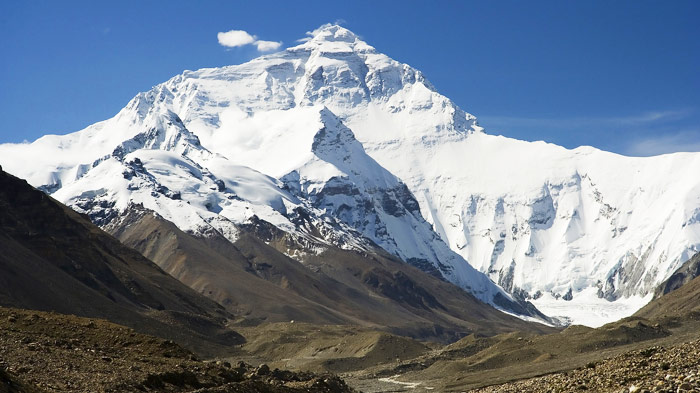 Mt. Everest
Mt. Everest
Across the border in Nepal, the topography is a little different, with less of an arid, tundra landscape, and more green valleys and forests. At a lower elevation than Tibet, Nepal has a different diversity of flora and fauna to Tibet. Large forests cover huge expanses of the countryside, with high mountains towering above low-lying, green valleys. The landscape changes as the elevation decreases towards the low Terai Plains. In the Himalaya region of the country, the elevation ranges from 4,000 to 8,000 meters, but drops drastically to the mountains below, averaging around 3,000 meters above sea level. The Mahabharat range, which lies even lower, extends to 2,700 meters at its highest point, before the landscape drops away to the lower Churia Hills.
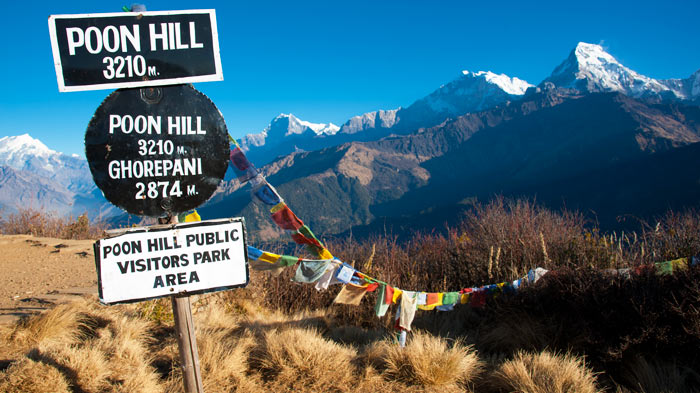 Poon Hill
Poon Hill
Trekking in the two places is also just as different as their geography. In the high altitude of Tibet, all treks are hard, with low oxygen levels, and rougher, harsher terrain. In Nepal, many treks are done at the lower levels, with only a few reaching the high Himalayan elevations, such as the trek to Everest Base Camp. For many treks in Nepal, the terrain is less rough and harsh than in Tibet, with more grasslands and tree-filled valleys to cover.
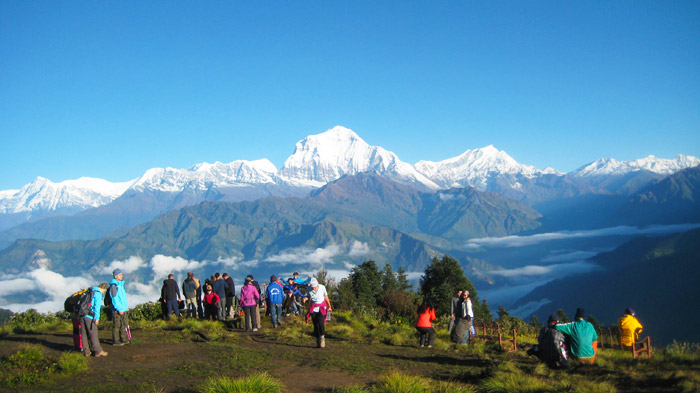 Enjoying the trekking of Poon Hill
Enjoying the trekking of Poon Hill
There are other sights that can be seen in Nepal as well as the grassy plains and green valleys. Lumbini is one of the most famous Buddhist pilgrimage sites in Nepal, and is the place where the Buddha, Siddhartha Gautama was born in 623 BC. One of its most famous pilgrims was the Indian emperor, Ashoka, whose pillar still stands in the world famous gardens. And the first ever national park in Nepal, the Chitwan National Park, is one of the best places to visit for animal lovers. They have hundreds of species of birds and animals in the reserve, including the Royal Bengal Tiger, The Gharial Crocodile, and the One-horned Rhinoceros.
>> Join-in the Most Popular Tibet Trekking Tours
Exploring the Mystery of Tibetan Buddhism and Nepali Hinduism and the Connections Between the Two Religions
While Tibet is a predominantly Buddhist region, Nepal was traditionally a Hindu state. Hinduism is the majority religion in Nepal, and has a profound influence on its social structure. With over 80% of Nepalese being Hindu, there is some issue as to the complexity of religion in Nepal. Many people, who naturally follow Hinduism, also practice aspects of Buddhism. And since both religions are Dharmic religions, it is not unusual for both religions in Nepal to accept, and even practice, each others religions. Combined religious beliefs are fairly common, and a 2015 constitution has allowed equal rights to all religions in the country. Tibetan Buddhism is also practiced in certain parts of Nepal, and some of the regional people are practicing it as their sole religion, instead of Hinduism. And there is a major connection between the beliefs and rites of both Hinduism and Buddhism in Nepal.
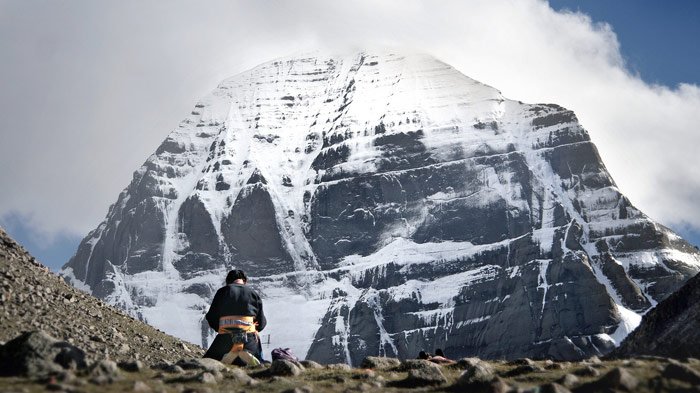 Holy Mt. Kailash
Holy Mt. Kailash
The best example of the connection lies in the holy Mt. Kailash, in Tibet. This mountain exists as a part of both Hindu and Buddhist religions, as well as playing a major part in Jainism and Bon. Both Hinduism and Buddhism believe that the mountain is the center of their religion. In Hinduism, the mountain is the home of Lord Shiva, the destroyer of evil, and he resides at the summit where he sits in eternal meditation with his wife, Parvati. The four faces of the mountain are believed to be made of crystal, ruby, gold, and lapis lazuli, and it is known to be a pillar of the world, located at the heart of six mountain ranges that make the shape of the lotus.
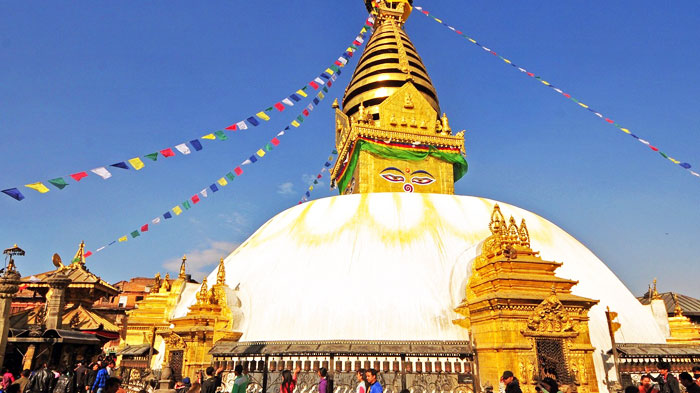 Swayambhunath Stupa
Swayambhunath Stupa
Buddhists believe that the mountain is the home of the Buddha Demchog, also known as Chakrasamvara, who is believed to represent supreme bliss. It is also the site of the ancient battle between Milarepa and Naro Bon-chung, the leader of the Tibetan shamanic religion known as Bon, and where Milarepa defeated him thus bringing Buddhism as the main religion in Tibet.
There are also a number of Buddhist temples and monasteries in Nepal, such as the Swayambhu Mahachaitya in Kathmandu, the Maya Devi Temple at Lumbini, and the Namobuddha Monastery at Simalchaur Syampati. For people on a journey of pilgrimage, these sites are popular destinations, with travelers coming from India and further to visit. For tourists, they show another side to the Buddhist monasteries from those in Tibet, and are just as fascinating in their structures and histories.
>> Join-in the Most Classic Mount Kailash Tours
A Taste of the Distinct Tibetan and Nepalese Cuisine, and the Comparisons of the Cuisines
Nepal is a place where the tastes of many different countries come together. While the country has its own popular dishes, much of the cuisine in Nepal is a combination of ingredients, characteristics and techniques from the neighboring countries. However, Nepalese food has had its own gastronomic history as well.
Just as the people of Nepal have many different backgrounds and ethnicities, so does the food in this region of the Himalayas. Nepalese dishes are usually healthier than most South Asian cuisine, and useless fats and more vegetables, salads, and lean meat. And since the country only opened up to foreign trade in the 1950s, it has added to the focus on using locally grown produce in the Nepali diet.
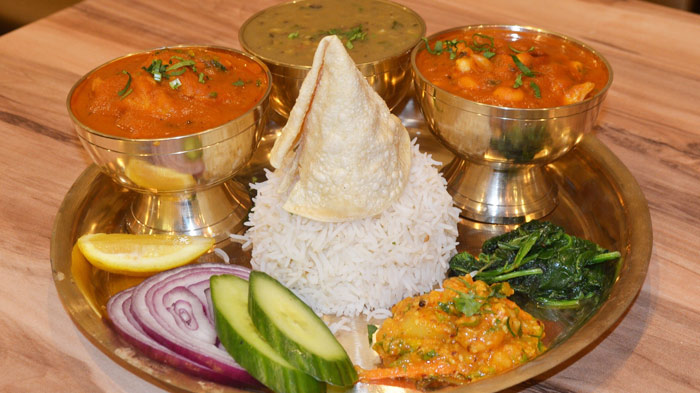 Nepalese Cuisine
Nepalese Cuisine
There is a tendency to use more spices in Nepalese food than in Tibetan, although the use of vegetables and yogurt is common between the two cuisines, as are the momos, thukpa – a version of a thick noodle soup. However, Nepalese cuisine is typically Asian in its use of rice. Unlike in Tibet – until recently – rice is a staple of the typical Nepalese diet, and can normally be found at most meals. However, unlike other Asian countries, there is a tendency across Nepal to serve Pulao, cooked rice with vegetables and lightly seasoned with turmeric and cumin. Known in the west as Pilaf or Pilau rice, this is popular throughout the country, and is often served with accompaniments such as yogurt and papadums.
Detailed Guide to Lhasa to Kathmandu Tour with Poon Hill Trek in Pakhara, Nepal
One of the best tours to cover the sights of both Tibet and Nepal is the forteen-day tour from Lhasa that incorporates Shigatse, Everest Base Camp, Mt. Kailash, Kathmandu, and Poon Hill in Pokhara.
Day 1 Arrival in Lhasa
The tour starts in Lhasa, after taking the train across the Qinghai-Tibet Plateau. You will have the chance to rest and get used to the increased elevation in your hotel.
Day 2 Lhasa Tour - Potala Palace, Jokhang Temple, Barkhor Street
On the second day your first stop will be the world famous Potala Palace, the winter palace of the Dalai Lama. Sitting atop Moburi (Red Hill), the palace looks down on the town of Lhasa from its 3,750-meter vantage point. The temple dates back to the 7th century, and houses artifacts and works of art from throughout Tibetan History. The palace also has the gilded burial stupas of the past Dalai Lamas, and below ground lies the ancient meditation cave of the 33rd King of Tibet.
After some lunch, you will head downtown to Jokhang Temple, the primary seat of the Gelugpa sect of Tibetan Buddhism. It was built by the 33rd King of Tibet in 647AD, and is the spiritual center of Tibet and the holiest temple in Tibetan Buddhism. Inside sits the most precious object in the temple, a life-sized statue of Buddha Sakyamuni when he was just 12 years old. Adorned with many precious gems, this gilded statue is the most sacred object in Tibet.
Running around the temple is the famed Barkhor Street. As well as the route of the holy kora, or religious circumambulation, it is also the site of many sellers where you can buy authentic souvenirs from across the region. You can join the pilgrims on their clockwise walk around the temple.
Day 3 Lhasa Tour - Drepung Monastery, Sera Monastery
The day is spent on a trip outside Lhasa, first to Drepung Monastery, one of the Great Three monasteries of the Gelugpa sect. Sitting at the foot of Gambo Utse, 5 kilometers outside Lhasa, it was founded by Jamyang Choge, one of the disciples of Tsong Khapa, in 1416. The Ganden Potrang, sited in the southwest corner of the monastery, was the former residence of the Dalai Lama, until the move to the Potala Palace.
In the afternoon you will travel back across the city to the northern suburbs, to visit Sera Monastery, another of the Great Three monasteries. Founded in 1419, the name, Sera, means "wild rose" in Tibetan, and was named because of the roses that were in bloom on the hill behind it when it was built. The main attraction of the monastery is the colorful and animated debating of the monks, held under the trees in the debating field every afternoon.
Day 4 Lhasa (3650m) to Shigatse (3900m) Via Gyantse
In the morning, our guide will drive you from Lhasa to Shigatse, Tibet's second largest city. En route to Shigatse you will pass over Gampala Pass, which lies at an elevation of 4,790 meters, and will pass the amazing Lake Yamdrok. At 4,400 meters above sea level, the lake lies nestled between lofty mountains, and you will see the holy mountain, Nyenchen Khangsar, its 7,191 meter peak standing tall in the distance. The trip to Gyantse passes close by the Karola Glacier, and at Manak Dam Lake you will be able to hang a prayer flag at the Simila Mountain Pass.
In Gyantse, you will get to visit the unique Pelkor Monastery, which is rare due to it housing three different sects of Tibetan Buddhism under one roof. You will also get to see the Gyantse Kumbum, a giant architectural stupa that stands 34 meters high. After another hour and a half of driving you will reach Shigatse, and will be able to visit the traditional barley mill and in summer you can view the spectacular sight of the barley fields in full crop.
Day 5 Shigatse (3900m) to EBC (5200m) Via Tingri
Before leaving Shigatse, you will get to visit the seat of Tibet's second highest spiritual leader, the Panchen Lama, at c. After obtaining your Alien's Travel Permit, which is needed to tour this area, you will leave Shigatse for Lhatse, a small town where you can get a nice lunch.
On the drive on to Shegar, weather permitting, you will get your first look at the amazing sight of Mt. Everest, or Mt. Qomolangma as it is called in Tibetan. The route will go over the Tsola Pass, at 4,600 meters, and the Gyatso-la Pass, which is higher at 5,248 meters. On entering the Mt. Everest National Nature reserve you will be able to enjoy the amazing panoramic view of the Himalayas as you travel over Gawula Pass, at an elevation of 5,198 meters. After arriving at Rongbuk you will be able to rest from the long drive, ready for the trip to EBC.
Day 6 EBC to Gyirong Border
In the morning you will first visit Rongbuk Monastery. The highest monastery in the world, at 5,000 meters above sea level, it is part of the Nyingmapa Sect of Tibetan Buddhism, and is unique in that both monks and nuns live together in the same monastery. From there it is a short hike of 4km to EBC, where you can take photos of the peak from the best vantage point, the closest place to Everest it is possible to get.
After EBC, you will drive to Gyirong port, taking in the breathtaking vista of Mt. Shishapangma and Pe-kutso Lake. The road goes past the Ghungtang Lhamo, at 5,236 meters, and you will arrive in Gyirong in the late afternoon.
Day 7 Gyirong to Nepal Border
In the morning, your guide will assist you to exit China, and will see you off at the border with Nepal. After transferring to Kathmandu, you will get to rest in your hotel, or spend the rest of the day looking around the local area.
Day 8 Tour around Kathmandu
A full day is set for visiting the areas in and around Kathmandu, and giving you time to prepare for the six-day trek ahead.
Day 9-14 Poon Hill Trek in Pokhara
After you rise from a good night’s sleep, you will travel to the Annapurna region, for trekking at Poon hill. Poon Hill offers the best trekking in Nepal, with spectacular mountain scenery, and dense forests of rhododendrons that are full of birds and small animals.
From Pokhara you will drive to Naya Pul, where you will start the trek to Tikhe Dhunga. This leg of the trek takes around four hours, and you will stay overnight in a lodge. In the morning you will leave Tikhe Dhunga for the trek to Ghorepani, which takes around six hours of walking. The trek here is mainly uphill, and the destination is already 2,850 meters. After staying the night in a lodge, you will take the final leg of the trek to Poon Hill, which takes at least six hours, and rises to an elevation of 3,200 meters.
For the route back, the trail goes on a different path first to Tadapani, a six hour walk, and then to Ghandrung the following day, which takes around four hours. The last part of the trek, to Pokhara, goes via Birethanti, and is mostly downhill to the destination at just 820 meters. Finally, the last day is spent driving back from Pokhara to Kathmandu, where you will be able to rest in your hotel.

Kham Sang is responsible and honest with more than six years of guide experience in Tibet.She has strong interpersonal skills and can communicate effectively with tourists.


.jpg)




0 Comment ON "Why Traveling from Tibet to Nepal Should Be on Your Bucket List"